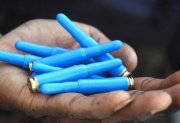Rubber bullet
Rubber bullets are rubber or rubber-coated projectiles fired from firearms. They are usually (but not always) non-lethal, unless fired at short range, but are often heavy enough to pierce skin. Rubber, plastic, wax, and wooden bullets are often used in riot control and to disperse protests. Rubber bullets may also be used for short range target practice.
Contents |
Crowd control use
Development
The British use the name baton round (not to be confused with the flexible baton round). It was first used in the late 1960s, when 25mm teak (hardwood) cylinders were fired to control rioters in Hong Kong. The round and its later developments were widely used in Northern Ireland. The first death to result from its use occurred in April 1972, when Francis Rowntree, an 11-year old boy, was hit in the head by a round fired at close range in Belfast. The wooden round was soon replaced by a new development, which was commonly called the rubber bullet.
Use in the UK
The initial British rubber bullet was 150mm (6 inches) long, 38mm (1.5in.) in diameter, and about 145g (4oz.); it used rubberized plastic around a metal core. It was fired from a modified and lengthened Very pistol named the L67. The new rounds were first used in Belfast by the British Army in August, 1970. Almost 56,000 rounds of this type were fired up until 1975. The instructions for firing the round indicated that it should be fired at the ground so as to ricochet into the target. When fired directly, the round could, and did, cause serious injury. Seventeen people have died as a direct result of, or due to injuries sustained by, these rounds in Northern Ireland since 1969. A new type of projectile named the plastic bullet or plastic baton round was introduced in 1972; initially used alongside the rubber bullet, it eventually replaced it.
Recreational use
Rubber bullets, powered only by a primer, are usually used for short-range indoor target practice or training, generally only with handguns. They are intended only for target shooting, unlike paintballs, which are intended for use on live targets. Rubber bullets, if used with a suitable backstop, can be recovered undamaged after firing, and reused numerous times.
